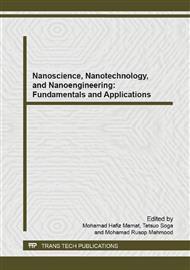[1]
S. Iijima, Helical microtubules of graphitic carbon, Nature. 354 (1991) 56-58.
DOI: 10.1038/354056a0
Google Scholar
[2]
R. Kumar, R. S. Tiwari, and O. N. Srivastava, Scalable synthesis of aligned carbon nanotubes bundles using green natural precursor: neem oil, Nanoscale Research Letters, 6 (2011) 1-6.
DOI: 10.1186/1556-276x-6-92
Google Scholar
[3]
A. B. Suriani, A. Azira, S. F. Nik., R. M. Nor, and M. Rusop, Synthesis of vertically aligned carbon nanotubes using natural palm oil as carbon precursor, Materials Letters, 63 (2009) 2704-2706.
DOI: 10.1016/j.matlet.2009.09.048
Google Scholar
[4]
K. Hernadi, A. Fonseca, J. B. Nagy, D. Bernaerts, and A. Lucas, Fe-catalyzed carbon nanotube formation, Carbon, 34 (1996) 1249-1257.
DOI: 10.1016/0008-6223(96)00074-7
Google Scholar
[5]
R. Sen, A. Govindaraj, and C. Rao, Carbon nanotubes by the metallocene route, Chemical physics letters, 267 (1997) 276-280.
DOI: 10.1016/s0009-2614(97)00080-8
Google Scholar
[6]
R. Bonadiman, M. D. Lima, M. J. De Andrade, and C. Bergmann, Production of single and multi-walled carbon nanotubes using natural gas as a precursor compound, Journal of materials science, 41 (2006) 7288-7295.
DOI: 10.1007/s10853-006-0938-2
Google Scholar
[7]
M. Wienecke, M. C. Bunescu, K. Deistung, P. Fedtke, and E. Borchartd, MWCNT coatings obtained by thermal CVD using ethanol decomposition, Carbon, 44 (2006) 718-723.
DOI: 10.1016/j.carbon.2005.09.020
Google Scholar
[8]
S. Paul, and S. Samdarshi, A green precursor for carbon nanotube synthesis, New Carbon Material, 26 (2011) 85-88.
DOI: 10.1016/s1872-5805(11)60068-1
Google Scholar
[9]
S. F. Nik, N. F. A. Zainal, A. Azira, F. Mohamed, S. Abdullah, A. Z. Ahmed, and M. Rusop, Functionality of inoculums in fermented glutinous rice for the preparation of carbon nanotubes, Solid State Science and Technology, 18 (2010) 330-336.
DOI: 10.4028/www.scientific.net/amr.667.277
Google Scholar
[10]
M. J. A. Marcon, M. A. Vieira, K. Santos, K. N. Simas, R. M. C. Amboni, and E. R. Amante, The effect of fermentation on cassava starch microstructure, Journal of Food Process Engineering, 29 (2006) 362-372.
DOI: 10.1111/j.1745-4530.2006.00073.x
Google Scholar
[11]
S. R. Couto and M. A. Sanroman, Application of solid-state fermentation to food industry- A review, Journal of Food Engineering, 76 (2006) 291-302.
DOI: 10.1016/j.jfoodeng.2005.05.022
Google Scholar
[12]
R. Misra, S. Acharya, and S. K. Sahoo, Cancer nanotechnology: application of nanotechnology in Cancer therapy, Drug Discovery Today. 15 (2010) 842-850.
DOI: 10.1016/j.drudis.2010.08.006
Google Scholar
[13]
M. Wang, and M. Thanou, Targeting nanoparticles to cancer, Pharmacological Research, 62 (2010) 90-99.
Google Scholar
[14]
A. Shvedova, V. Castranova, E. Kisin, D. Schwegler-Berry, A. Murray, V. Gandelsman, A. Maynard, and P. Baron, Exposure to carbon nanotube material: assessment of nanotube cytotoxicity using human keratinocyte cells, Journal of Toxicology and Environmental Health Part A, 66 (2003) 1909-1926.
DOI: 10.1080/713853956
Google Scholar
[15]
N. A. Monteiro-Riviere, R. J. Nemanich, A. O. Inman, Y. Y. Wang, and J. E. Riviere, Multi-walled Carbon nanotube interactions with human epidermal keratinocytes, Toxicology Letters, 155 (2005) 377-384.
DOI: 10.1016/j.toxlet.2004.11.004
Google Scholar
[16]
W. Ke, K. Shao, R. Huang, L. Han, Y. Liu, J. Li, Y. Kuang, L. Ye, J. Lou, and C. Jiang, Gene delivery targeted to the brain using an Angiopep-conjugated polyethyleneglycol- modified polyamidoamine dendrimer, Biomaterials, 30 (2009) 6976-6985.
DOI: 10.1016/j.biomaterials.2009.08.049
Google Scholar
[17]
C. Lin, B. Fugetsu, Y. Su, and F. Watari, Studies on toxicity of multi-walled carbon nanotubes on Arabidopsis T87 suspension cells, Journal of Hazardous Materials, 170 (2009) 578-583.
DOI: 10.1016/j.jhazmat.2009.05.025
Google Scholar
[18]
D. Cui, F. Tian, C. S. Ozkan, M. Wang, and H. Gao, Effect of single wall carbon nanotubes on human HEK293 cells, Toxicology Letters, 155 (2005) 73-85.
DOI: 10.1016/j.toxlet.2004.08.015
Google Scholar
[19]
J. Wang, P. Sun, Y. Bao, J. Liu, and L. An, Cytotoxicity of single-walled carbon nanotubes on PC12 cells, Toxicology In Vitro, 25 (2011) 242-250.
DOI: 10.1016/j.tiv.2010.11.010
Google Scholar
[20]
L. Belyanskaya, S. Weigel, C. Hirsch, U. Tobler, H. F. Krug, and P. Wick, Effects of carbon nanotubes on primary neurons and glial cells, Neurotoxicology, 30 (2009) 702-711.
DOI: 10.1016/j.neuro.2009.05.005
Google Scholar
[21]
S. R. Avancini, G. L. Faccin, M. A. Vieira, A. A. Rovaris, R. Podesta, R. Tramonte, N. M. de Sauza, and E. R. Amante, Cassava starch fermentation wastewater: characterization and preliminary toxicological studies, Food and Chemical Toxicology, 45 (2007) 2273-2278.
DOI: 10.1016/j.fct.2007.06.006
Google Scholar
[22]
M. S. Dresselhaus, G. Dresselhaus, R. Saito, and A. Jorio, Raman spectroscopy of carbon nanotubes, Physics Reports, 409 (2005) 47-99.
DOI: 10.1016/j.physrep.2004.10.006
Google Scholar
[23]
C. M. Chen, M. Chen, F. C. Leu, S. Y. Hsu, S. C. Wang, S. C. Shi, and C. F. Chen, Purification of multi-walled carbon nanotubes by microwave digestion method, 13 (2004) 1182-1186.
DOI: 10.1016/j.diamond.2003.11.016
Google Scholar
[24]
H. Li, N. Zhao, C. He, C. Shi, X. Du, and J. Li, Thermogravimetric analysis and TEM characterization of the oxidation and defect sites of carbon nanotubes synthesized by CVD of methane, Materials Science and Engineering, 473 (2008) 355-359.
DOI: 10.1016/j.msea.2007.04.003
Google Scholar
[25]
H. L. Karlsson, J. Gustafsson, P. Cronholm, and L. Möller, Size-dependent toxicity of metal oxide particles-a comparison between nano-and micrometer size, Toxicology letters, 188 (2009) 112-118.
DOI: 10.1016/j.toxlet.2009.03.014
Google Scholar
[26]
M. Haussler, N. Sidell, M. Kelly, C. Donaldson, A. Altman, and D. Mangelsdorf, Specific high-affinity binding and biologic action of retinoic acid in human neuroblastoma cell lines, Proceeding of the National Academy of Science of the United States of America, 80 (1983) 5525-5529.
DOI: 10.1073/pnas.80.18.5525
Google Scholar
[27]
R. J. Scheibe, D. D. Ginty, and J. A. Wagner, Retinoic acid stimulates the differentiation of PC12 cells that are deficient in cAMP-dpendent protein kinase, 113 (1991) 1173-1182.
DOI: 10.1083/jcb.113.5.1173
Google Scholar


